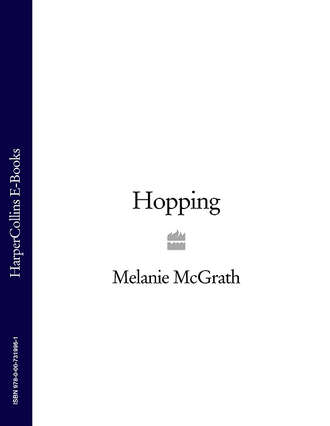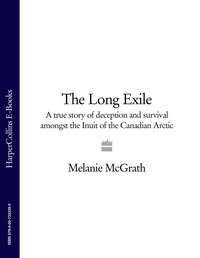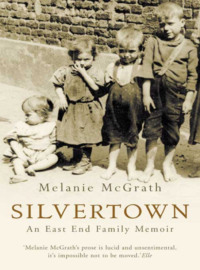
Полная версия
Hopping

HOPPING
The Hidden Lives of an East End
Hop Picking Family
Melanie McGrath

For Tai, who looked forward to this book.
‘Kent, sir – everybody knows Kent – apples, cherries, hops, and women.’
CHARLES DICKENS, The Pickwick Papers
PREFACE
A few years ago I wrote a memoir of the lives of my grandparents, Jenny Fulcher and Leonard Page. In the telling of my grandparents’ story I wanted to capture the essence of two ordinary lives and to tell the story of the East End of London during an extraordinary period which saw it transform from what Jack London called the ‘abyss’– a hive of poverty and deprivation whose dimmed population toiled in sweatshops, factories and in the docks – to the less impoverished but more socially fragmented place it is today; a place associated not so much with economic deprivation (though there is still far too much of that) as with a hip art scene, vibrant Banglatown, Canary Wharf city slickers and, most recently, with the massive regeneration programme in disguise that is the 2012 Olympics.
Having told that story in Silvertown, the most obvious next step would have been to have continued my family story into the present day. To have done that, though, would have been to ignore completely one of the greatest of the East End’s many great traditions: hopping. Every summer throughout the eighteenth, nineteenth and much of the twentieth centuries, hundreds of thousands of East Enders made the trip to the hop gardens of Kent to pick hops. My own family were among the minority who didn’t regularly go on these trips. My grandmother, Jenny Fulcher, regarded hopping as common and, as concerned as she was with respectability, avoided it. My mother went once or twice, but the hop never became part of her life.
But it was at the centre of the lives of many, if not most, East Enders; so much so, in fact, that the annual hop was referred to, not without irony, as ‘The Londoners’ holiday’. It would hardly count as one today – the hoppers, mostly women and children, worked long hours in sometimes difficult conditions – but the annual hop constituted a break from the smoke and grime of the East End and as such it became the nearest thing to a holiday that most would ever see. Mothers, in particular, looked forward to bringing their children down to the countryside for their health, and for many East End children the annual hop was their only opportunity to run about unhampered by roads and vehicles and noise, to breathe air uncontaminated by factory waste and smoke, to watch the sun go down and look out across wide open spaces to the horizon beyond. The money East End women earned by picking hops was usually the only part of the family income over which they had control, and it was often used to buy children the boots and coats they would need for the coming winter.
The tradition of employing Londoners to pick hops in Kent began in the mid-fifteenth century when Flemish weavers first began cultivating the bines in the Kentish weald, though it’s possible that cultivation itself began long before, since we know that the Romans, who marched into Britain through Kent along what is now the A2 Dover-to-Canterbury road, brought hops with them. The first recorded hop garden in Britain was thriving at Westbere near Canterbury in 1520, and hops were still growing on the same site more than 450 years later.
The hop plant, Humulus lupulus, a relative of cannabis, is a fast-growing herbaceous perennial which dies back to its rhizome in the winter. Although vine-like, it is strictly speaking a bine, the stout stems being covered with little hairs to assist in its clockwise clambering habit. Though hardy, it requires deep, well-draining loamy soil and shelter from the wind, and in the soft undulations of the Kentish downland, Flemish weavers found the perfect growing conditions. At that time, hopped beer was virtually unknown in Britain, but it had long been popular in central and northern continental Europe. All over medieval Europe, beer was a relatively safe substitute for water, which was often contaminated. In Britain, people tended to drink ale, a much heavier, sweeter drink, brewed without hops. Adding hops to beer not only imparts a grassy, bitter flavour and a spicy aroma, but the acids in the hop resin have a mild antibiotic effect which assists the work of the yeast and, along with the alcohol itself, helps preserve the beer for longer. Hopped beer can thus be brewed with a lower alcohol content than ale, which makes it a more practical substitute for water.
There were numerous early attempts to restrict hop production in Britain – Henry VIII forbade his own brewer to use such foreign fripperies and his Catholic daughter, Mary Tudor, condemned the hopping of beer as a nasty Protestant habit. All the same, the popularity of hops grew with the practically minded British, and many growers also became brewers, planting hop gardens for use in their own breweries and building drying oasts, the word taken from Flemish. During the sixteenth and seventeeth centuries, gardens were planted all over southern and central England, but the hops continued to flourish best in Kent, where there was a ready supply of sweet chestnuts with which to make poles to support the bines, the enclosed fields provided shelter, and the hops did not have far to travel to the vast breweries of London. So important did Kent become in hop production that in 1681 the London hop market moved from Little Eastcheap to Borough to be nearer to the main thoroughfare to Kent.
During the fifteenth and sixteenth centuries, troops of indigents, Gypsies and Irish and a few Londoners poured into Kent to pick the hop crop, staying on to pick the apples, pears and plums that also flourished in the ‘garden of England’, but the real inflow of Londoners began after the mid-seventeenth century, when Londoners took to drinking beer rather than the gin they had previously favoured, and Kentish farmers began to plant more hops to meet the demand. At first, only the poorest and the most desperate for work came, either walking the fifty or so miles from the East End of London to the Weald or, for the few who could afford the passage, travelling by boat as far as Gravesend and on foot from there to the gardens in north and east Kent. On the way, these new migrants slept in cart and cow sheds and in pigsties on mattresses of old hopbines, or, if there were none around, under hedges.
By the end of the seventeenth century Britons were consuming 300,000 hundredweight of hops every year, more than half of which were grown in Kent. A hundred and fifty years later 40,000 acres of Kentish loam were being put down to hop gardens, each acre requiring 200 pickers, numbers that could be met only by bringing Londoners down in their thousands.
As luck would have it, the hop boom coincided with the development of the railways. By the 1850s the Southeastern Railways company and the East Kent Company were putting on special hoppers’ trains in the season, using cattle trucks as carriages, and the Joint Transport Committee of Railways and Farmers began printing postcards that farmers could send to London hoppers, allocating them a picking spot and a place on one of the ‘hoppers’ specials’. By 1867, demand was so great that Kentish farmers started using hiring agents actively to recruit hoppers from the poorest districts in London: Poplar, Whitechapel, Limehouse, Bow, Stepney and parts of Hackney to the north of the river and Bermondsey and Southwark in the south.
Families began returning to the same farms every year, often giving up their jobs and homes in order to do so. Whole neighbourhoods came en bloc, and set up their London streets in the rows of hop huts. By 1878, 72,000 acres of Kent were laid to hops and 250,000 mostly women and children were making the three- or four-week trip into Kent every year to pick them. Of these, nearly half were Londoners. And so a social and cultural event unique to Britain was born.
As I was researching the ‘Londoner’s Holiday’ and thinking I would like to write about it, a letter arrived from a man who had read Silvertown and knew of my grandparents. For the purposes of this story, I am calling this man Richie Baker. A relative of Richie’s had worked in my grandparents’ greasy spoon for a while, and his aunt, who I’m calling Daisy Crommelin, counted my grandmother, Jenny Fulcher, among her friends. At some point in the 1970s, Daisy and my grandmother stopped seeing one another. Whether they disagreed over something or the friendship simply ran its course, I don’t know. Jenny Fulcher outlived Daisy Crommelin but I’m pretty sure Jenny did not go to Daisy’s funeral; the friendship clearly died some considerable time before Daisy herself.
From such seemingly tenuous connections, Richie and I established a regular correspondence, during which Richie began to reveal, bit by bit, his family story.
Daisy and her husband Harold Baker, Richie’s uncle, led ordinary lives in extraordinary times. Using Richie’s letters and doing some research of my own, I began to piece together the story of their relationship. For Daisy, the annual hop was a kind of Oz, the place where life meted out most of its magic. It is no exaggeration to say that, along with her family, hop picking was one of the central pillars of Daisy’s life. Harold had other pleasures, as we shall see, but he was no less of a family man. On the surface, the marriage between Daisy and Harold could be seen as a pact between two people driven together by common wounds and a shared sense of fragility, the feeling that they were never more than a beat away from disaster. The contrast between the delicacy of their position and the harshness of the conditions in which they lived was one of the habitual ironies of survival in the East End in the first part of the twentieth century. As I dug around further and came to understand them more deeply, though, I realised that pain and practicality alone could not explain the bond these two people shared.
Theirs was, I believe, a great love affair, not in the Hollywood style, an explosive melange of sentimentality and sex, but in a much more profound and, perhaps, old-fashioned way. Harold and Daisy lived by the same principles. To survive and flourish in a place and at a time that offered little other than fellow travellers and almost nothing by way of second chances, they understood that happiness in life was to be found by making the most of whatever small, bright joys might flit by. For Harold and Daisy, as for many couples, the joys were not always to be had from the same things, but they tolerated each other’s small claims on happiness and thereby created much for themselves. Theirs was a marriage of affectionate solidarity. Like all couples, they made compromises, but unlike many, they kept each other’s confidences. They proved their love through unshakeable loyalty.
The story here belongs first and foremost to Daisy and Harold. They are not here to give their consent to my telling their story but, knowing their lives are worth the telling, I have taken the liberty of doing so. To protect their posthumous privacy I have changed their names and many others of people in this story. Like many people living in straitened circumstances in the East End of the twentieth century, Harold and Daisy did not leave a written record of their lives. There are no diaries or extensive correspondence, few official letters or documents. Richie knew them, of course, and there were others who remembered them and the events of their lives, but no two people’s recollection of any event is ever identical. My correspondence with Richie and subsequent investigations are the canvas on to which I have embroidered. Some of the facts have slipped through the holes – we no longer know them nor have any means of verifying them – and in these cases I have reimagined scenes or reconstructed events in a way I believe reflects the essence of the scene or the event in the minds and hearts of the people who lived through it. Had I stuck strictly to the knowable and verifiable facts, the lives of Daisy and Harold, and many of the other people in this story, would not have been recorded on paper. To my mind this literary tinkering does not alter the more profound truth of the story. The lives Daisy and Harold led were in some ways emblematic; they were lives that, in their broad sweep, could have been lived by any number of hundreds of thousands of East Enders born in the first quarter of the twentieth century. Their struggles and triumphs were, if not the same, then similar enough to countless others to allow Daisy and Harold in some way to stand in for those who left no records and who may already have been forgotten.
Harold Baker and Daisy Crommelin were good, ordinary people. They were not celebrities or champions of anything, they achieved nothing of public note and left little behind when they died. Their lives were the most ordinary, least likely kind of lives to be put down on paper. That is why I have chosen to record them.
Contents
Title Page Dedication Epigraph Preface Chapter One Chapter Two Chapter Three Chapter Four Chapter Five Chapter Six Chapter Seven Chapter Eight Chapter Nine Chapter Ten Chapter Eleven Chapter Twelve Chapter Thirteen Chapter Fourteen Chapter Fifteen Chapter Sixteen Chapter Seventeen Chapter Eighteen Epilogue Acknowledgements Also By Melanie Mcgrath Copyright About the Publisher
CHAPTER 1
It was on a Monday in the early winter of 1913 that ten-year-old Daisy Crommelin’s childhood came to an end. The day began ordinarily enough. At six or thereabouts, Daisy and her younger sister, Franny, were woken by their mother Elsie, and creeping from their bed so as not to disturb the lodger, Mrs Anderson, and her daughter, Maisie, who were sleeping beside them, the two girls threw on their overcoats and made their way down the rickety stairs to the scullery below. The room was dank and smelled of stewed trotters from the night before. Elsie had made their usual breakfast of mashed bread in milk and was now applying Union Jack corn paste to her feet and tutting over her chilblains. The girls’ father, Joe, Freeman of the River, was rinsing off his cut-throat razor in an enamel bowl beside the sink, singing to himself and trying to ignore his wife. Seeing Franny, of whom he was particularly fond, he said:
How’s me little princess?
Today, as always, Daisy tried not to mind her father’s favouritism. She told herself that you couldn’t expect to be loved as much when you weren’t the pretty one. In any case, her father might love Franny more, but she, Daisy, had loved him longer. She brought over the two bowls her mother had prepared and sat them on the table. Joe Crommelin finished up his task and sat himself down before the plate of fried bread and faggots Elsie had made for him. Franny clambered on to his lap and all three tucked into their food in contented silence. At a quarter to seven Joe Crommelin rose from the table, threw on his blue serge lighterman’s garb and kissed his daughters goodbye. As he reached the door, Franny called out:
Kiss me again, Dad, and Joe, delighted by the pretty little creature he had helped bring into the world, turned and said:
Dad’s gonna bring you something nice home.
Then he waved, went out of the front door and joined the general flow of men and women making their way towards the river.
Daisy watched her father go with the usual tug of pride. Just before she was born, so her mother said, a group of dockers had set on Joe on account of the free water clause which made it legal for ships to bypass the docks and unload directly into lighters. The dockers supposed that lightermen like Joe were taking their jobs. Joe had suffered horrible injuries, and the shock of it, so Elsie said, not only brought on Daisy’s birth too early but was in some indefinable way responsible for her oafish ears, her spindly neck and fuzzy brown hair.
With Joe gone, Elsie put the washing copper on to boil with a handful of carboxyl then fetched herself some Beecham’s Powders on account of it being a Monday and her nerves playing up. On Mondays, Elsie did the family laundry and took in neighbours’ washing and was usually rather grumpy, and the children knew better than to risk vexing her further. Daisy plaited her sister’s velvety hair and turned her attentions to the washing up. Just before eight, she laced her boots, which were too tight, rolled up the sleeves of her winter coat so she could see her hands, said goodbye to her mother and sister and went out into the rusty air of Bloomsbury Street.
At this moment in her life, Daisy Crommelin’s world – which she took to be all the world there was – comprised a huddle of streets, riverside factories, railway yards and docks about two miles long and a mile deep, flanked on the western side by the district of Limehouse and to the east by the River Lea. This was the parish of Poplar, five miles to the east of Tower Bridge, in London’s East End.
A few hundred years earlier Poplar had been a sybaritic little fishing settlement on the banks of the Thames. The river currents carved a natural deep basin on the eastern, seaward, side of Poplar at what is now Blackwall, and by the fifteenth century it had become an anchorage for the trading ships discharging their cargoes on to barges. Soon enough, a pier was built and named Brunswick after its chief financier, and in 1606 it was from this pier that the Virginia Settlers set sail to found the first permanent colony in North America. A company of shipbuilders set up shop nearby and continued to build ships at Blackwall for three centuries until the last remnant of the old business closed in 1980.
The settlement came to be called Poplar after a single tree which lay on the road leading east out of London towards the sea, and by the late eighteenth century it had a permanent population of 4,500 and was temporary home to thousands of sailors working on the tea clippers moored up on Brunswick Pier and Blackwall Wharf. To the west of the anchorage, a number of smart terraces went up, and at a polite distance from these the East India Company built almshouses for the seafaring poor. By then Poplar was a bustling, prosperous little place, growing plump on the proceeds of marine trades, its tarry turnings connected by a web of rope-walks. In 1802, anxious to protect its cargo from pilfering, the West India Company opened its first large inland dock in Poplar and added a new waterway, the City Canal, dug from marsh on the Isle of Dogs on Poplar’s southern side. The new West India Dock was a wonder of modern engineering, with space for 600 clippers, each up to 1,000 tonnes in size, and nine five-storey warehouses, protected by 20-foot-high walls and looming gates. Four years later, the East India Company followed suit, opening its own dock just a few miles east at Blackwall and building two new roads, the East India Dock Road and the Commercial Road, to connect the docks to the city.
Thousands of impoverished rush cutters and weavers from the dwindling Essex rush beds, eel fishermen and agricultural labourers flooded into the area to take up navvying jobs in the construction of the docks. Among these were Daisy’s ancestors on her mother’s side. Gradually, the shipowners and merchants of old Poplar slipped away to quieter, greener districts and their once grand houses were soon split into multi-occupancy lodgings. Speculators threw up tenements and turnings and dingy rents on the marshy ground and the place began, bit by bit, to accumulate the flotsam and jetsam of human desperation. Drinking and gambling dens appeared, brothels looked out on to open sewers, and poorhouses, missions, soup kitchens and charitable lodgings soon went up to serve the most basic needs of the fallen and destitute. The river became a dumping ground for sewage, industrial waste and the leavings of slaughterhouses.
In the middle of the nineteenth century, the area changed again, when the North London and the Great Eastern railways arrived, chopped the little place in two and blanketed it in coal dust, smuts and grease. A giant gas works went up in the east, beside the River Lea, followed by sawmills, a jam factory, chemical works, a corn mill, a metallic cask works, breweries, a paint works and a factory making incandescent mantles. People joked that in a prevailing westerly wind, you could smell Poplar all the way to France.
Exiles from remote wars and famines and distant pogroms began pouring into Poplar, and by the time Daisy Crommelin was born, in 1903, the district was the poorest in London; 40 per cent of Poplar’s inhabitants lived with their families in a single room.
The Crommelins had escaped the worst of the poverty. Joe’s trade, piloting lighters across the Thames from ship to jetty, was protected by a guild and, though his wages were modest, they were regular. Elsie had been in domestic service until Joe had rescued her with his offer of marriage, and she now supplemented the family income by taking in laundry and assembling silk flowers. They occupied the scullery and the downstairs front room of number 7 Bloomsbury Street; the girls shared their bedroom with Mrs Anderson and Maisie and the second bedroom was rented to a distant cousin. There was a yard with a yard dog and a privy shared with next door. Modest thought it was, the Crommelins were proud of their home, knowing it to be several steps up from some of the rat-, child-and scandal-infested sinks in the street. Only two doors down lived Helen Reid. No one had ever seen a Mr Reid and one of ‘Mrs’ Reid’s four children was a half-breed. The Reids shared their house with old Flossie Lumin, who could regularly be seen out at night picking drunken fights with anyone who came by. Then there were the Greenbergs on the corner, not only Jewish, but anarchists too! Elsie had it that Bloomsbury Street got more common the farther down it you went. According to Elsie, the most distant end, which she called The Deep, was a hotbed of ruffians, criminals and loose women, and she forbade her two girls from going there or speaking to anyone who had. To distinguish her family from the residents of The Deep, Elsie spent much of her time scrubbing, whitening, blackening, polishing, mending, ironing, sweeping, dusting and bleaching. The Deep and the dirt were close bedfellows, she said. Respectable folk kept them both at bay.
In Elsie’s opinion, the only close neighbours who passed muster, despite being Irish, were the Shaunessys next door at number 5. Marie Shaunessy was a sweet-hearted, only mildly bossy woman who had married a hard-working French polisher called Patrick, and they had a son, Billy, who, unbeknown to Elsie, was a crybaby and a pincher. Billy Shaunessy would often wait for Daisy in a little alleyway a few blocks farther down the street then fire pieces of coal at her with his catapult, but when Daisy had once tried to wrest the catapult from him, he had pinched her then burst into tears in such an alarming manner that Daisy thought it better, on balance, to put up with the barrage of fired coals than risk Mrs Shaunessy finding out what a hopeless booby she had for a son, for Daisy loved Mrs Shaunessy. She and Franny would often go round to the Shaunessys’ while their mother recovered from one or other of her digestive and nervous complaints, and the two Crommelin girls viewed Mrs Shaunessy as a sort of maternal stand-in. Many were the nights that Daisy would lie in bed wishing that she and Franny could be Mrs Shaunessy’s daughters. Maybe their mother could have Billy in return. A year or two before Daisy was born, Elsie had birthed twin boys, but they had both died very shortly afterwards and, in accordance with East End custom, Elsie hadn’t attended the funeral.
If I’d only seen me twinnies laid in their boxes, she would say, I wouldn’t suffer these bonce aches, and this gnawing in me bones.








